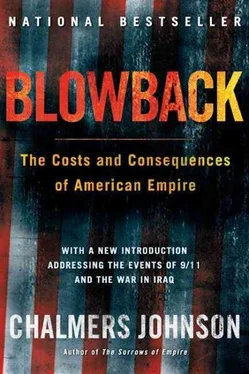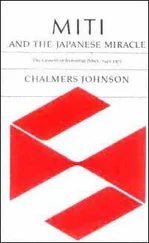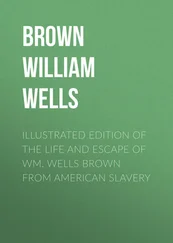Chalmers Johnson - Blowback, Second Edition - The Costs and Consequences of American Empire
Здесь есть возможность читать онлайн «Chalmers Johnson - Blowback, Second Edition - The Costs and Consequences of American Empire» весь текст электронной книги совершенно бесплатно (целиком полную версию без сокращений). В некоторых случаях можно слушать аудио, скачать через торрент в формате fb2 и присутствует краткое содержание. Год выпуска: 0101, ISBN: 0101, Издательство: Macmillan, Жанр: Старинная литература, на английском языке. Описание произведения, (предисловие) а так же отзывы посетителей доступны на портале библиотеки ЛибКат.
- Название:Blowback, Second Edition: The Costs and Consequences of American Empire
- Автор:
- Издательство:Macmillan
- Жанр:
- Год:0101
- ISBN:9780805075595
- Рейтинг книги:5 / 5. Голосов: 1
-
Избранное:Добавить в избранное
- Отзывы:
-
Ваша оценка:
- 100
- 1
- 2
- 3
- 4
- 5
Blowback, Second Edition: The Costs and Consequences of American Empire: краткое содержание, описание и аннотация
Предлагаем к чтению аннотацию, описание, краткое содержание или предисловие (зависит от того, что написал сам автор книги «Blowback, Second Edition: The Costs and Consequences of American Empire»). Если вы не нашли необходимую информацию о книге — напишите в комментариях, мы постараемся отыскать её.
Blowback, Second Edition: The Costs and Consequences of American Empire — читать онлайн бесплатно полную книгу (весь текст) целиком
Ниже представлен текст книги, разбитый по страницам. Система сохранения места последней прочитанной страницы, позволяет с удобством читать онлайн бесплатно книгу «Blowback, Second Edition: The Costs and Consequences of American Empire», без необходимости каждый раз заново искать на чём Вы остановились. Поставьте закладку, и сможете в любой момент перейти на страницу, на которой закончили чтение.
Интервал:
Закладка:
As the administrator of the martial law then in effect, Chun became the de facto ruler of the country. He had to move carefully, however, because he lacked legitimacy within the South Korean legal system and because he could not be certain that all of the armed forces were behind him. Not unlike the “thaw” in Eastern Europe in 1956, there was widespread anticipation that the next election, whose date had not yet been set, would usher in the democracy that had failed to develop after the overthrow of Syngman Rhee in 1960.
On April 14, 1980, acting president Choi, now totally subordinate to Chun, promoted him to the rank of lieutenant general and appointed him acting director of the KCIA. These actions prompted student demonstrations throughout the country. Molotov cocktails were hurled at police formations, and the police retaliated with hypervirulent CS tear gas (the same type used by the FBI at Waco in 1993). Everyone knew that Chun had to consolidate his position before the National Assembly convened for the first time since Park’s death on May 20, when the Democratic Republican Party, the façade behind which Park had ruled, was likely to join with the opposition in ending martial law. That would have destroyed any legal basis for Chun’s political ambitions.
In a secret cable dated May 7, 1980, preceding a scheduled meeting with General Chun, Ambassador Gleysteen wrote to his superiors in Washington: “In none of our discussions will we in any way suggest that the USG [U.S. government] opposes ROKG [Republic of Korea government] contingency plans to maintain law and order, if absolutely necessary, by reinforcing the police with the army [italics added].” The next day Warren Christopher cabled back, “We agree that we should not oppose ROK contingency plans to maintain law and order.” Pat Derien, who was President Carter’s assistant secretary of state for human rights, later said to Shorrock that this was “a green light as far as I could see then and as far as I can see now.” She went on to accuse Holbrooke of “pandering to dictators” and of “national security hysterics.” 12
General Chun did not wait long after talking with Gleysteen to complete the coup d’état he had begun the previous December. Late on the night of May 17, 1980, General Chun expanded martial law, closed the universities, dissolved the National Assembly, banned all political activity, and arrested thousands of political leaders. 13Unlike Park, Chun had no following whatsoever outside the army. All Korean cities were tense with fury at his usurpation of power, but only in Kwangju did the situation explode, much in the same way it had in Budapest twenty-four years earlier. What resulted was, in the words of historian Donald Clark, “the most notorious act of political violence in South Korea’s history.” Professor Clark adds that the explicit American endorsement of Chun’s recapture of the city “forever associated the United States with the Kwangju Massacre.” 14
On May 18, 1980, a few hundred demonstrators in Kwangju took to the streets to protest the imposition of martial law. They were met by paratroopers of the 7th Brigade of the Korean special forces, known as the “black berets,” who had a well-known reputation for brutality going back to their service on the American side in the Vietnam War. The 7th Brigade also included a battalion of infiltrators and provocateurs, who wore their hair long and dressed to look like students. According to eyewitnesses, the special forces troops set about bayoneting all the young men and women they could find and attacked others with flamethrowers. In a May 19 cable to Washington, Gleysteen wrote, “Rumors reaching Seoul of Kwangju rioting say special forces used fixed bayonets and inflicted many casualties on students. . . . Some in Kwangju are reported to have said that troops are being more ruthless than North Koreans ever were.”
In reaction to these acts of state terrorism, the whole population of Kwangju and sixteen of the twenty-six other municipalities of the South Cholla region rose in rebellion. They drove the paratroopers from the city, which citizens’ councils controlled for the next five days. They appealed to the U.S. embassy to intervene, but General Wickham had already released from his United Nations Command the forces Chun would use to retake the city. Gleysteen later claimed that he was unable to verify the authenticity of the mediation request and therefore decided not to act. “I grant it was the controversial decision, but it was the correct one. Do I regret it? I don’t think so.”
On Wednesday, May 21, martial law command headquarters in Seoul broke its near total censorship of what was going on in Kwangju and reported that 150,000 civilians, about one-fifth of the city’s population, had gone “on a rampage” and that they had seized 3,505 weapons and 46,400 rounds of ammunition from arsenals and had commandeered 4 armored personnel carriers, 89 jeeps, 50 trucks, 40 wreckers, 40 buses, 10 dump trucks, and 8 tear-gas-firing jeeps. 15On the same day, Ambassador Gleysteen wrote to Washington that a “massive insurrection in Kwangju is still out of control and poses an alarming situation for the ROK military.” He said that the Korean military was “concentrating defense on two military installations and a prison containing 2,000 leftists. . . . The December 12 generals obviously feel threatened by the whole affair.”
In the cables released to Tim Shorrock, there is ample evidence that the American embassy knew about the transfer of the special forces to Kwangju and what was likely to happen when they applied their well-known skills to civilians. In cables dated May 7 and May 8, Ambassador Gleysteen had gone into detail on the numbers of special forces brigades brought into Seoul and around Kimpo Airport “to cope with possible student demonstrations.” On May 8, the U.S. Defense Intelligence Agency had sent a cable to the Joint Chiefs of Staff at the Pentagon saying that all Korean special forces brigades “are on alert.” “Only the 7th Brigade remained away from the Seoul area,” and “was probably targeted against unrest at Chonju and Kwangju universities.”
Under the Combined Forces Command (CFC) structure, Korean special forces (as distinct from all regular army units) were outside joint U.S.-Korean control and did not need U.S. approval to be moved. However, it was routine for the Koreans to inform the CFC of any troop movements. In Gleysteen’s May 7 cable, he speculates that the Koreans might ask for approval to move the ROK 1st Marine Division. “There has been no request for such approval yet, but CINCUNC [Commander in Chief of the United Nations Command] would agree if asked.” In a May 22 cable, Gleysteen describes “the extent to which we were facilitating ROK army efforts to restore order in Kwangju and deter trouble elsewhere.” However, he told the South Korean foreign minister, “We had not and did not intend to publicize our actions because we feared we would be charged with colluding with the martial law authorities and risk fanning anti-American sentiment in the Kwangju area.”
In Washington, D.C., on May 22, the newly created Policy Review Committee on Korea met at the White House to consider what the United States should do. Its members included newly appointed secretary of state Edmund Muskie, President Carter’s national security adviser Zbigniew Brzezinski, the director of central intelligence Admiral Stansfield Turner, and the secretary of defense Harold Brown, plus Christopher, Holbrooke, and Gregg. Brzezinski, himself a Polish-American and an authority on the Soviet Union’s satellites in Eastern Europe, summarized the consensus of the meeting: “In the short-term support, in the longer term pressure for political evolution.” According to the minutes transmitted to Gleysteen, “There was general agreement that the first priority is the restoration of order in Kwangju by the Korean authorities with the minimum use of force necessary without laying the seeds for wide disorders later.”
Читать дальшеИнтервал:
Закладка:
Похожие книги на «Blowback, Second Edition: The Costs and Consequences of American Empire»
Представляем Вашему вниманию похожие книги на «Blowback, Second Edition: The Costs and Consequences of American Empire» списком для выбора. Мы отобрали схожую по названию и смыслу литературу в надежде предоставить читателям больше вариантов отыскать новые, интересные, ещё непрочитанные произведения.
Обсуждение, отзывы о книге «Blowback, Second Edition: The Costs and Consequences of American Empire» и просто собственные мнения читателей. Оставьте ваши комментарии, напишите, что Вы думаете о произведении, его смысле или главных героях. Укажите что конкретно понравилось, а что нет, и почему Вы так считаете.










